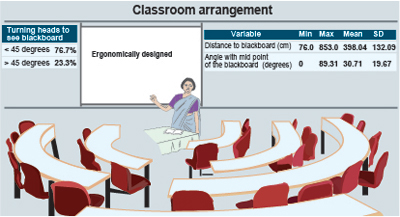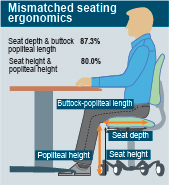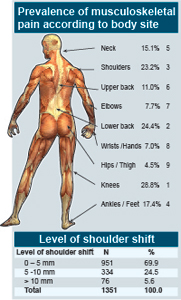Getting the bigger lesson right
Community Physician Dr. Kapila Jayaratne
The moment a little one is accepted by a school at five-plus to begin his primary education, the parents are relieved. There is a sense that “everything is alright”.
Parents see a bright future ahead, the path clear – primary, secondary and tertiary education, with the child emerging into society with a recognised degree, to be able to stand on his own feet, hold a good job, marry and have children of his own.

How many look into the numerous issues that the child may face within the classroom environment, asks Consultant Community Physician Dr. Kapila Jayaratne of ‘healthy-school bag’ fame, answering that it is not many.
Referring to ‘child ergonomics’ and its far-reaching impacts, he explains that “ergon” means work and “nomos” “natural laws”. Therefore, ergonomics is the adjustment of tools, equipment and the environment to suit human characteristics, in this case, the child. This systems-oriented discipline now applies to all aspects of human activity.
Dr. Jayaratne equates the ‘school’ to a ‘place of work’, with the children being ‘workers’ there.
Then what are the ergonomic factors in the school?
The list is simple – classroom furniture, seating arrangements, position of the blackboard, school bag, IT equipment and the surroundings which includes lighting, sound and vibrations, MediScene learns.
The negative effects of mismatched ergonomics, which many parents and school authorities are oblivious to, are many. Musculoskeletal pain, general tiredness, postural changes, spinal deformities and psychological problems, stresses Dr. Jayaratne.

This Chairperson of the Expert Committee on Ergonomics is not talking without proof. To get “solid data” on school environments he has studied a sample in the Gampaha district.
The scientifically selected sample of 1,607 children in the age-group 11-13 was from Grades 6, 7 and 8 and Dr. Jayaratne had looked at simple things such as the location of the child in relation to the blackboard, the angle that the child had to rotate to see the blackboard and the frequency of seat and row change of the child.
Looking at the positives, this expert says that many children (78%) had individual desks and chairs, while 22% shared their desks. Checking out the chairs he has, however, found that although 96% had a backrest, only 1% had both backrests and hand-rests.
Dealing with seating ergonomics, he is quick to point out that there was a huge 87% “mismatch” of the seat depth and buttock – popliteal length (pertaining to the area behind the knee) and an 80% mismatch of seat height and popliteal height.

In simple language it would mean that both the size of the seat and the height of the seat were unsuitable for the children, MediScene understands. Even the desk-chair combination was mismatched in 76%.
The minimum distance to the blackboard was 75cm and the maximum 853cm, with 77% of the children having to turn their heads less than 45 degrees, but 23% more than 45 degrees, MediScene learns.
Dr. Jayaratne then picks on his “favourite” – the healthy school bag, pointing out that 80% of children using a backpack was a positive factor. Shoulder bags had been carried by 18%, suitcases by 2%, trolley cases by 0.1% and ‘hand carriage’ by 0.1%.
The healthy features were that in 92%, the backpacks had padded shoulder straps and in nearly 100% movable straps. But only 30% had waist belts and 10% compartments, according to him. Backpack behaviour also brought out positive signs with 97% using it on both shoulders as opposed to one shoulder. But only 31% used the waist-belt, he lamented.
Reiterating that according to international standards the bag weight should only be 10% of the body weight of the child carrying it, he says that in the group he studied more than half the children (58%) were carrying bags weighing over that which included 14% lugging a heavier load of more than 15% of their body weight on their back.

Children carried their bags, on average, a distance of 4 km back and 4 km forth, while the time the weight was on their backs was about 50 minutes, before and after school.
Meanwhile, at a recent seminar at the Sri Lanka Medical Association, Prof. Manori Senanayake, Professor in Paediatrics at the Colombo Medical Faculty, said that there is a severe misconception that children are “little adults”.
Not only are children different to adults, their abilities also vary, so there cannot be common tools. This is why ergonomics is important for proper development, she said.
Citing the example of how a child gains the skill of gripping the pencil gradually and the need to have pencils to suit this development, she said that if all the desks and chairs in the classroom are the same size, children who are bigger-built than the others would be in difficulty.
It is not only in the classroom that practical measures should be taken such as having a cupboard where extra books can be stored but ensuring that children pack their books according to a proper timetable.
Even at home, the taps should be at a particular height to enable a child to open them and windows in classrooms should not only allow adults to look out but also children.
A child-friendly environment is essential for the all-round development of children, was the message being delivered loud and clear.
School fatigue
The survey in the Gampaha district has shown up the negative health effects very clearly. All 1,607 children surveyed had indicated ‘general tiredness’ with 611 complaining of ‘mild’ tiredness, 657 of ‘moderate’ tiredness and 339 of ‘severe’ tiredness.
The findings with regard to musculoskeletal pain had been more startling, with 463 children having no pain, but 306 having ‘acute’ pain, 261 ‘one-time’ pain and a large 577 ‘recurrent’ pain. This is why Dr. Jayaratne calls musculoskeletal pain a “hidden” problem among early adolescents.
When the children were checked for a “shoulder level shift” due to unhealthy schoolbags, it had been found that in 70% the shift was 0-5mm, in 25% 5-10mm and in 5% over 10mm.
Both the research findings and recommendations have been shared with the Education Ministry, Dr. Jayaratne added.
Follow @timesonlinelk
comments powered by Disqus




















